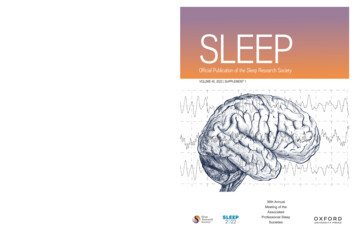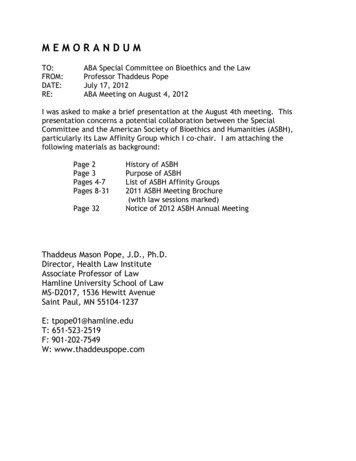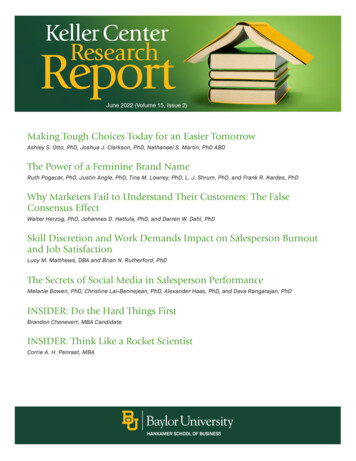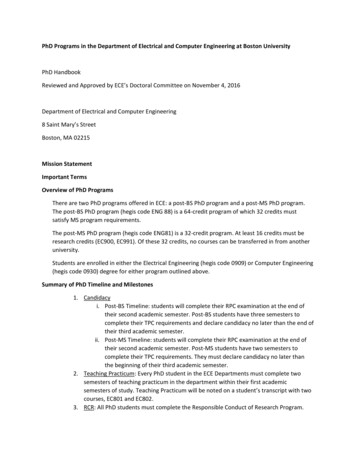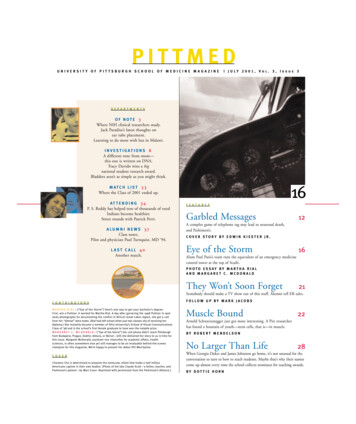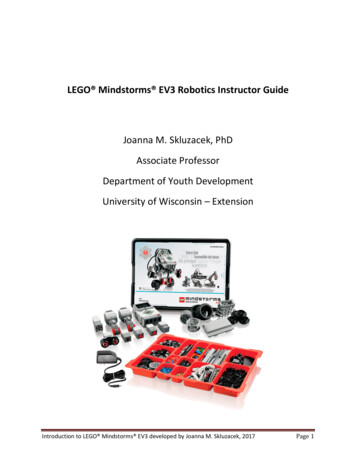
Transcription
LEGO Mindstorms EV3 Robotics Instructor GuideJoanna M. Skluzacek, PhDAssociate ProfessorDepartment of Youth DevelopmentUniversity of Wisconsin – ExtensionIntroduction to LEGO Mindstorms EV3 developed by Joanna M. Skluzacek, 2017Page 1
Introduction to LEGO Mindstorms EV3This curriculum packet is an introduction to LEGO Mindstorms EV3 robotic system with the v 2.1programming software. The curriculum can assist even the most novice instructor in gaining experienceand confidence in robotics and help advanced instructors to easily implement new challenges into theirclub or group setting.The goals of this guide are to: Provide background and research on how robotics’ projects help youth develop STEM (science,technology, engineering and math) content and life skills, Summarize essential information about LEGO Mindstorms EV3 robotic system, Assist in troubleshooting technology problems and, Provide detailed instructions and solutions for robotic challenges.Why RoboticsA recent study by the President's Council of Advisors on Science and Technology found: "Economicforecasts point to a need for producing, over the next decade, approximately 1 million more collegegraduates in STEM fields than expected under current assumptions." The shortage of skilled STEMworkers has been documented in several research papers (Bayer Corp., 2012; Fadigan & Hammrich,2004; Grasso, Callahan, & Doucett, 2004; Smith, Heck, & Worker, 2012; Tran & Nathan, 2010) andgovernment reports (Beatty & National Research Council, 2011; Committee on Prospering in the GlobalEconomy of the 21st Century & Committee on Science Engineering and Public Policy, 2007; NationalResearch Council, 2011; Nielsen & National Research Council, 2011). One proposed solution to this issueis to engage youth at a young age and throughout their formative years in STEM programs and projects,while inspiring them to seek out job opportunities within a STEM field. Teaching youth STEM throughrobotics allows the student to learn content knowledge of a subject area by applying the content in areal-world context. There are many examples of how robotic systems are used daily and this connectionbetween educational programs and real-world skills enables students view the relevance in theireducational programs.Studies specific to LEGO Mindstorms suggest youth gain problem solving skills, creative thinking skillsand an increase in scientific-technological knowledge (Barak & Zadok, 2009; Barker, 2007; Chen Yuan,2012; Lindh & Holgersson, 2007; Mosley & Kline, 2006; Nagchaudhuri, 2002; Slangen, van Keulen, &Gravemeijer, 2011). Other studies show youth who worked with LEGO Mindstorms systemsimproved in-school performance in STEM related disciplines (Cejka, Rogers, & Portsmore, 2006;Panadero, Romaacuten, & Kloos, 2010). The inherently interdisciplinary nature of the Mindstorms robotic systems encourages participants to use different types of skills and has proved to capture youthin long-term engagement which increases content mastery. Since the robot is created from LEGO building blocks, youth have an almost infinite array of configurations they can build, inspiring creativityand increasing engagement. The incorporation of computer programming into the project allowsparticipants to become more comfortable with technology and computer operations.Introduction to LEGO Mindstorms EV3 developed by Joanna M. Skluzacek, 2017Page 2
Alignment with 4-H Youth Development OutcomesThis curriculum is meant to serve as a resource for adult and youth leaders in robotics. The anticipatedoutcomes of using this resource are:Adults will increase their comfort and confidence in leading STEM-based activities.Adults will gain familiarity with the experiential learning model.Youth will increase their involvement in 4-H STEM project opportunities.Youth will demonstrate creativity, innovation and critical thinking skills.Youth can justify their decisions about their programming strategy.Youth can use information gained through trial-and-error programming to refine decisionmaking skills.Youth can develop their own robotic challenges and express creativity and critical thinking.Since there is not one right way to complete a challenge, youth can be creative in their roboticprogram.Youth will increase their ability to work collaboratively with others.Youth will work in pairs or teams to complete challenges.Youth will respect others opinions on how to solve problems.Youth will be able to improve communication skills.Youth will be able to reflect on successes and failures in programming and describe the issues.Youth will use technology to help express ideas.Youth will learn how to deal with stress and trial-and-error in programming.Alignment with 4-H Science Abilities, 4-H Science Process Skills and STEM Content ExpertiseThe 4-H Science Abilities are divided into overarching process skills. These seven process skills are:observing, questioning, hypothesizing, predicting, investigating, interpreting, and communicating.Several of these skills are described in the previous section. In addition to life skill developmentoutcomes, youth who use robotics as a platform for learning also gain abilities specific to STEM content.For instance, youth will observe how the robot performs, question why the robot performed as it didand troubleshoot the program using the information gathered. Specifically, participants will improvetheir basic computer operation skills (save and open files, cut and paste tools); gain experience withapplication of basic math functions (addition, subtraction, etc.); apply geometry to calculate turn radiusand wheel rotation distance; and use units of measurement along with measurement estimation andcomparison.How to Use This Curriculum GuideIt is highly recommended to review the video resources found on the 4-H EV3 robotics webpage:https://fyi.uwex.edu/wi4hstem/lego-ev3/ as these materials will enable you to gain the basics of theIntroduction to LEGO Mindstorms EV3 developed by Joanna M. Skluzacek, 2017Page 3
EV3 system, such as turning on the robot and locating saved files. This curriculum guide does not discussbuilding the robot, turning on the robot, finding saved files nor does it provide a software tutorial.This manual is designed to be used with the LEGO Mindstorms EV3 base set robot and the LEGO Mindstorms EV3 education software purchased from the LEGO online store (http://www.lego.com).There are other robots available through other vendors, but some of these kits do not have the samecomponents as the base set LEGO kit. The software also comes in a free “home edition” download. Allthe challenges presented in this curriculum guide can be performed with either the software edition.The LEGO Mindstorms EV3 robotic kits are available for check-out through the University ofWisconsin-Extension Media Library for a nominal fee. Many county extension offices also have robotickits and laptops available for lending. It is recommended to have one robot and computer (loaded withthe software) per two youth participants.The lessons are created to be used with the “basic robot” configuration. This means the robot is builtaccording to the instruction manual that comes with the base set kit. The building instruction manualprovides stepwise procedures for building, along with length scale keys so youth can easily find the rightsized part by comparing it to the picture.The curriculum provided in this guide is for the instructor; however, the guide may be edited for youthparticipants depending on the teaching strategy, objectives and venue of the program. For example, theinstructor can give the participants the challenge instructions as text only or a full programming guide. Ifparticipants are given the text only, the instructor will need to have more direct teaching time todescribe the programming blocks and the details of downloading the program from the computer to therobot.The full pictorial programming guide can be given to youth directly, however; this in only recommendedif the instructor has very little time for the session, for instance, if the program is a marketing event for arobotics camp or club project. It might also be helpful to give youth the full programming guide for thefirst activity as part of a longer session. In this instance, the instructor should take time for the group todiscuss each programming block and the variables associated with the programming, since the youthwill not develop this understanding by using the complete pictorial guide alone.The complete pictorial guides provide examples of solutions to complete the challenges. It is importantto remember that there are multiple ways to successfully complete challenges and youth areencouraged to be creative with their programming. It is also important to recognize that the numbersfor duration, etc. provided within the complete pictorial guide are estimates. The robot will performdifferently under different conditions. Examples of performance variables are described in the Distanceand Turns Instructor Guide.Troubleshooting TipsMake sure the battery is charged. The rechargeable battery is reliable and does last a long time (at least15 hours) when charged, however; if the robot has been left unused for a long period of time or exposedto cold weather during transport or shipping the battery might be discharged.Having AA batteries on hand may be helpful if the battery is not working properly.Introduction to LEGO Mindstorms EV3 developed by Joanna M. Skluzacek, 2017Page 4
When using the ultrasonic sensor remind the youth to not have their hands in front of the sensor whenthey press the button to start the program. The sensor will sense their hand and the robot willimmediately travel backwards.There are two ways to build the light sensor in the building manual. In one configuration the light sensoris pointing straight forward and in the other configuration the light sensor is pointing down. Make sureto select the correct configuration for the task.ResourcesThis curriculum guide is meant to serve as an introduction to robotics and provide a few roboticchallenges to get instructors started using this engaging learning environment. However, LEGO Mindstorms robotic systems are widely used and there are several other places to find teachingresources. One important resource is a tutorial entitled “Robot Educator” that is embedded into the EV3software.Figure 1: Area to click to select the Robot Educator Tutorial Guide.Below is a list of teaching resources:STEMcentric EV3Texas Tech University RoboticsDr. Graeme EV3 LessonsRobotics 1 with EV3 (Ohio State 4-H)Robotics 2 EV3N More (Ohio State 4-H)Introduction to LEGO Mindstorms EV3 developed by Joanna M. Skluzacek, 2017Page 5
ReferencesBarak, M., & Zadok, Y. (2009). Robotics projects and learning concepts in science, technology andproblem solving. International Journal of Technology and Design Education, 19(3), 289-307.Barker, B., & Asnorge, J. (2007). Robotics as Means to Increase Achievement Scores in an InformalLearning Environment. Journal of Research on Technology in Education, 39(3), 229-243.Bayer Corp. (2012). Bayer Facts of Science Education XV: A View from the Gatekeepers-STEMDepartment Chairs at America's Top 200 Research Universities on Female andUnderrepresented Minority Undergraduate STEM Students. Journal of Science Education andTechnology, 21(3), 317-324.Beatty, A. S., National Research Council. Committee on Highly Successful Schools or Programs for K-12STEM Education, National Research Council. Board on Science Education & National ResearchCouncil. Center for Education. Board on Testing and Assessment. (2011). Successful STEMeducation : a workshop summary. Washington, D.C.: National Academies Press.Cejka, E., Rogers, C., & Portsmore, M. (2006). Kindergarten robotics: Using robotics to motivate math,science, and engineering literacy in elementary school. International Journal of EngineeringEducation, 22(4), 711-722.Chen Yuan, C. (2012). An innovative knowledge management learning cycle by Lego NXT for scienceeducation. International Journal of Innovative Computing, Information & Control, 8(1B), 791798.Committee on Prospering in the Global Economy of the 21st Century & Committee on ScienceEngineering and Public Policy. (2007). Rising above the gathering storm : energizing andemploying America for a brighter economic future. Washington, D.C.: National Academies Press.Fadigan, K. A., & Hammrich, P. L. (2004). A longitudinal study of the educational and career trajectoriesof female participants of an urban informal science education program. Journal of Research inScience Teaching, 41(8), 835-860.Grasso, D., Callahan, K. M., & Doucett, S. (2004). Defining engineering thought. International Journal ofEngineering Education, 20(3), 412-415.Lindh, J., & Holgersson, T. (2007). Does lego training stimulate pupils' ability to solve logical problems?Computers & Education, 49(4), 1097-1111.Mosley, P., & Kline, R. (2006). Engaging students: a framework using LEGO robotics to teach problemsolving. Information Technology, Learning, and Performance Journal, 24(1), 39-4545.Nagchaudhuri, A., Singh, G., Kaur, M., George, S. (2002). LEGO Robotics Products Boost StudentCreativity in Pre-College Programs at UMES. Paper presented at the ASEE/IEEE Frontiers inEducation Conference, Boston, MA.National Research Council. Committee on Highly Successful Schools or Programs for K-12 STEMEducation, National Research Council. Board on Science Education, & National Research Council.Center for Education. Board on Testing and Assessment. (2011). Successful K-12 STEMeducation: identifying effective approaches in science, technology, engineering, andmathematics. Washington, D.C.: National Academies Press.Nielsen, N. & National Research Council. Planning Committee on Evidence on Selected Innovations inUndergraduate STEM Education. (2011). Promising practices in undergraduate science,Introduction to LEGO Mindstorms EV3 developed by Joanna M. Skluzacek, 2017Page 6
technology, engineering, and mathematics education : summary of two workshops. Washington,D.C.: National Academies Press.Panadero, C. F., Romaacuten, J. V., & Kloos, C. D. (2010). Impact of learning experiences using LEGOMindstorms reg in engineering courses 2010 IEEE Education Engineering 2010 - The Future ofGlobal Learning Engineering Education (pp. 503-512)Slangen, L., van Keulen, H., & Gravemeijer, K. (2011). What pupils can learn from working with roboticdirect manipulation environments. International Journal of Technology and Design Education,21(4), 449-469.Smith, M. H., Heck, K. E., & Worker, S. M. (2012). 4-H boosts youth scientific literacy with ANR watereducation curriculum. California Agriculture, 66(4), 158-163.Tran, N. A., & Nathan, M. J. (2010). The Effects of Pre-Engineering Studies on Mathematics and ScienceAchievement for High School Students. International Journal of Engineering Education, 26(5),1049-1060.Introduction to LEGO Mindstorms EV3 developed by Joanna M. Skluzacek, 2017Page 7
Instructor GuideTitle: Distance the robot will travel based on wheel sizeIntroductionCalculating the distance the robot will travel for each of the duration variables (rotations, degrees,seconds) can be confusing for participants especially when coupled with a turn or a spin. It is importantto remember that rotations and degrees reference the wheel axle, such that these distances can changedepending on the size of the tire installed on the robot. This activity outlines how to use the durationvariables correctly to make corner turns and to calculate the distance to objects using the circumferenceof the tire. The answers provided in the instructor guide are based on the basic bot construction fromthe LEGO EV3 .ObjectivesYouth will apply basic math functions and geometry.Youth will gain experience with units of measurement and measurement comparison.Youth will demonstrate creativity, innovation and critical thinking skills.Youth will increase their ability to work collaboratively with others.Youth will better understand the process of programming and evaluating robotic movements.Preparation and MaterialsOne-12 inch ruler per robotActivity: How far will your robot travel?Take a look at the larger tires connected to the gear motors on the NXT robot. On the side of these tiresthere are numbers. This is true for all tires and tells you the size (diameter and width) of the tire.Automobile tires and bicycle tires also have these numbers to ensure the mechanic places the correcttire size on each axle.1. What are the numbers on the robots large tire?56 X 282. Are these numbers are in inches, centimeters or millimeters?Millimeters3. Which number is the diameter and which is the width?56 mm diameter28 mm width4. Using the diameter of the tire, one can find the Circumference of the tire. The circumference ofa tire tells the distance a tire travels in one revolution:Where C circumference, π 3.14, and D diameterEV3 Distance.Developed by Joanna M. Skluzacek– Wisconsin 4-H2018Page 1
What is the circumference of the EV3 tire?This means one rotation of the tire is 175.84 mm or 17.6 cm.3.14X 56188415700175.84 mm5. If one rotation is equal to 17.6 cm, how many cm will the robot travel in three tire rotations?17.6 X 3 52.8 cm6. Since the wheel of the robot is a circle, one can also speak about degrees of tire rotation. Howmany degrees does the tire rotate for each tire rotation?1 tire rotation – 360 degrees7. How many cm will the robot travel if it is programmed to travel a duration of 720 degrees?720 degrees 2 tire rotations 35.2 cmHowever, the robot might not travel the distance you calculated. There are several variables that affectthe distance travelled by the robot: The power level setting will affect distance traveled when using the time interval in seconds;however, it will not affect the distance travelled in rotations or degrees. In addition the batterylife levels will also impact the amount of power provided to the robot to complete the moves. The external environment will impact the amount of friction on the tires. A smooth surface willhave less friction meaning the robot will travel slightly faster. A carpeted surface will have morefriction meaning the robot will travel slightly slower. The mechanics of the built robot impacts the function of the robot. For example if a tire is notperfectly aligned on the wheel well or on the axle you may experience a wobbly wheel. The temperature will affect the distance travel. Since the wheels are made out of rubber, theywill slightly expand when the temperature is hot and contract with the temperature gets colder.EV3 Distance.Developed by Joanna M. Skluzacek– Wisconsin 4-H2018Page 2
Instructor GuideChallenge Title:EV3 Four BricksIntroduction:There is no challenge mat for this activity and no sensors need to be connected to the robot. Thischallenge introduces participants to the move block and the relationship between the different durationtypes: rotations, degrees and seconds.ObjectivesYouth will demonstrate creativity, innovation and critical thinking skills. Youth will increase their abilityto work collaboratively with others. Youth will be able to improve communication skills. Youth willbetter understand the process of programming and evaluating robotic movements. Youth will increasetheir ability to design a solution to a challenge.Level of DifficultyEasyPreparation and MaterialsInstructor should determine teaching methodology (text instructions or pictorial programming guide)that best fits the audience.Print appropriate student materials.Time Required Programming:5-10 minutes (if participants are given the text instructions only).To run the course: less than a minute.Procedure of Programming StepsDepending on the expertise level of the participants, the instructor can give the youth the text of thesteps involved in the challenge or give them the entire pictorial programming guide.TEXT:1. Robot moves forward three tire rotations at 75% power.2. Robot moves backward 1080 degrees at 75% power.3. Robot moves forward for two seconds at 75% power.4. Robot moves forward while making a hard turn toward the right for 230 degrees at 75% power.EV3 Four Bricks.Developed by Joanna M. Skluzacek– Wisconsin 4-H.2018Page 1
Program Guide1. Robot moves forward three tire rotations at 75% power.2. Robot moves backward 1080 degrees at 75% power.3. Robot moves forward for two seconds at 75% power.4. Robot moves forward while making a hard turn toward the right for 230 degrees at 75% powerEV3 Four Bricks.Developed by Joanna M. Skluzacek– Wisconsin 4-H.2018Page 2
Connect the computer and the robot using the USB cord and make sure the robot is turned on.A. Download the program onto the robot by pressing the download button at the bottom rightcorner of the computer screen.B. Disconnect the robot from the USB cord.C. Find the program on the robot and use the dark gray button to start the program.Discussion QuestionsWhat difficulties did you encounter with the programming?What did you do to overcome these difficulties?How did the distance traveled by the robot in step 1 compare to the distance the robot traveled in step2?The robot moved the same distance. Three tire rotations equals 1080 degrees.EV3 Four Bricks.Developed by Joanna M. Skluzacek– Wisconsin 4-H.2018Page 3
Instructor GuideChallenge Title:EV3 Bark Like a DogIntroductionThis robotic challenge does not need a challenge mat. Youth can use their hand to activate the touchsensor. The robot configuration must include the touch sensor to complete the challenge.ObjectivesYouth will demonstrate creativity, innovation and critical thinking skills.Youth will increase their ability to work collaboratively with others.Youth will be able to improve communication skills.Youth will better understand the process of programming and evaluating robotic movements.Youth will increase their ability to design a solution to a challenge.Level of DifficultyEasyPreparation and MaterialsInstructor should determine teaching methodology (text instructions or pictorial programming guide)that best fits the audience.Print appropriate student materials.Time RequiredProgramming: 15 minutes (if participants are given text instructions only).To run the course: less than a minute.Procedure of Programming StepsDepending on the expertise level of the participants, the instructor can give the youth the text of thesteps involved in the challenge or give them the complete pictorial programming guide.TEXT:1.2.3.4.5.6.The robot waits five seconds before starting the program.The robot barks like a dog.The robot moves forward for 3 seconds at 80% power.The robot stops and waits for you to press the touch sensor.The robot moves backwards four tire rotations.The robot moves forward and uses the touch sensor to hit an obstacle (youth can use their handto activate the touch sensor).7. The robot moves backwards one tire rotation and stops.EV3 Bark Like a Dog.Developed by Joanna M. Skluzacek– Wisconsin 4-H2018Page 1
COMPLETE PICTORIAL PROGRAMMING GUIDE:1. The robot waits five seconds before starting the program.2. The robot barks like a dog.3. The robot moves forward for 3 seconds at 80% power.4. The robot stops and waits for you to press the touch sensor.5. The robot moves backwards four tire rotations.EV3 Bark Like a Dog.Developed by Joanna M. Skluzacek– Wisconsin 4-H2018Page 2
6. The robot moves forward and uses the touch sensor to hit an obstacle (youth can use their handto activate the touch sensor).7. The robot moves backwards one tire rotation and stops.EV3 Bark Like a Dog.Developed by Joanna M. Skluzacek– Wisconsin 4-H2018Page 3
A. Connect the computer and the robot using the USB cord and make sure the robot is turned on.B. Download the program onto the robot by pressing the download button at the bottom rightcorner of the computer screen.C. Disconnect the robot from the USB cord.D. Find the program on the robot and use the dark gray button to start the program.Discussion QuestionsWhat difficulties did you encounter with the programming?What did you do to overcome these difficulties?What other things might use a touch sensor?Automatic car washTouch screensWhat was the difference in the programming for the touch sensor in Step 3 versus Step 6?The robot was stopped and waited for you to touch the touch sensor in Step 3. In Step 6 therobot moved until the touch sensor was activated. In the programming, you alter the move blockbefore the sensor block.Why did you need to select “on” for the move block in Step 6?You needed to select “on” because you didn’t know how far away the obstacle was that wouldactivate the touch sensor.EV3 Bark Like a Dog.Developed by Joanna M. Skluzacek– Wisconsin 4-H2018Page 4
Instructor GuideChallenge Title:EV3 X Marks the SpotIntroductionThis robotic challenge uses a challenge mat. The robot configuration must include the touch sensor andthe ultrasonic (distance) sensor. The obstacle listed on the challenge schematic can be a wall or anyother object that will not move when struck by the robot. The participants will not be told the distancefrom the obstacle to the X. They will need to use trial-and-error to calculate the proper travel durationof the robot. For example, they might have to view how far the robot travels in one tire rotation andthen estimate how many rotations it will take to cover the required distance. The youth will also have touse trial-and-error to figure out how to make the robot turn the correct arc distance so the touch sensoris facing the obstacle after the robot spins on the X in step 6. They may also reference the “Distance theRobot Will Travel Based on Wheel Size” activity to estimate how many rotations or degrees it will taketo successfully complete the challenge.ObjectivesYouth will demonstrate creativity, innovation and critical thinking skills.Youth will increase their ability to work collaboratively with others.Youth will be able to improve communication skills.Youth will better understand the process of programming and evaluating robotic movements.Youth will increase their ability to design a solution to a challenge.Level of DifficultyIntermediatePreparation and MaterialsInstructor should determine teaching methodology (text instructions or pictorial programming guide)that best fits the audience.Print appropriate student materials.Create “X Marks the Spot” challenge mat using:Masking or painter’s tapeMeasuring tapePaper or poster board (at least 50 X 12 inches in size)Obstacle such as a weighted box, heavy book, or wall.EV3 X Marks the Spot.Developed by Joanna M. Skluzacek– Wisconsin 4-H2018Page 1
44 inchesobstacleEV3 X Marks the Spot.Developed by Joanna M. Skluzacek– Wisconsin 4-H2018Page 2
Time RequiredProgramming: 45 minutes – 1 hour (if participants are given text instructions only).To run the course: 2-3 minutes.Procedure of Programming StepsDepending on the expertise level of the participants, the instructor can give the youth the text of thesteps involved in the challenge or give them the entire pictorial programming guide.TEXT:The robot begins the challenge centered on the X facing toward the obstacle (ultrasonic sensor facingobstacle).1. The robot moves toward the obstacle at 50% power.2. The robot uses the ultrasonic sensor to detect the obstacle at a distance of 12 inches.3. Upon sensing the obstacle the robot moves backwards and stops at its original position(centered on the X as in step 1) without using any sensors.4. The robot spins in place one complete rotation so that the touch sensor is facing the obstacle.5. The robot moves toward the obstacle.6. The robot touches the obstacle with the touch sensor.7. Upon sensing the obstacle the robot moves backwards and stops at its original position(centered on the X as in step 1) without using any sensors.EV3 X Marks the Spot.Developed by Joanna M. Skluzacek– Wisconsin 4-H2018Page 3
COMPLETE PICTORIAL PROGRAMMING GUIDE:The robot begins the challenge centered on the X facing toward the obstacle (ultrasonic sensor facingobstacle).1. The robot moves toward the obstacle at 50% power.2. The robot uses the ultrasonic sensor to detect the obstacle at a distance of 12 inches.3. Upon sensing the obstacle the robot moves backwards and stops at its original position(centered on the X as in step 1) without using any sensors.4. The robot spins in place one complete rotation so that the touch sensor is facing the obstacle.5. The robot moves toward the obstacle.EV3 X Marks the Spot.Developed by Joanna M. Skluzacek– Wisconsin 4-H2018Page 4
6. The robot touches the obstacle with the touch sensor.7. Upon sensing the obstacle the robot moves backwards and stops at its original position(centered on the X as in step 1) without using any sensors.EV3 X Marks the Spot.Developed by Joanna M. Skluzacek– Wisconsin 4-H2018Page 5
Connect the computer and the robot using the USB cord and make sure the robot is turned on.A. Download the program onto the robot by pressing the download button at the bottom rightcorner of the computer screen.B. Disconnect the robot from the USB cord.C. Find the program on the robot and use the dark gray button to start the program.Discussion questionsWhat difficulties did you encounter with the programming?What did you do to overcome these difficulties?What strategies did you use to figure out the distance from the obstacle to the X?What strategies did you use to figure out how to program the robot to turn in step 6?Why did you need to select “on” for the move/steering block in Step 2?You needed to select “on” because you didn’t know how far away the obstacle was that wouldactivate the ultrasonic sensor.What other things might use a touch sensor?Automatic car washTouch screensWhat other things might use an ultrasonic (distance) sensor?Bats use ultrasound for navigation.Many motion detectors use ultrasound (burglar alar
Dr. Graeme EV3 Lessons. Robotics 1 with EV3 (Ohio State 4 -H) Robotics 2 EV3N More (Ohio State 4 -H) Introduction to LEGO Mindstorms EV3 developed by Joanna M. Skluzacek, 2017 Page 6 References Barak, M., & Zadok, Y. (2009). Robotics projects and learning concepts in science, technology and

